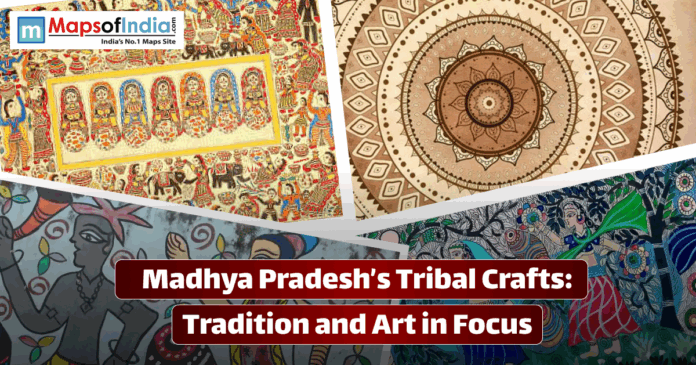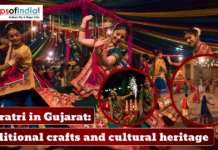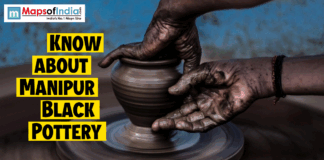Madhya Pradesh, the central state of India, has the blessing of different great tribal traditions and art heritage that is spread across the state. This state is also known for its big population of tribes spread across the state, and the crafts these tribal peoples create are variously linked to the crafts that show the link with nature, spirituality, and community life. The paintings that are done here vary from the elaborate Gond paintings to carefully made terracotta figures and bamboo craft. The tribal craftsmanship that is created in Madhya Pradesh we can find the tribal craftsmanship that contains the stuff from our day-to-day activities. The crafts created by these tribal communities are not only showpieces of art, but they are also the collective records that have been passed down over generations.
The Tribal Life of Madhya Pradesh
Madhya Pradesh is home to a diverse range of tribes, including the Gond, Bhil, Baiga, Korku, and Bhilal, among others. Every tribe possesses its own craft practices and customs rituals which symbolize their connection to nature. The crafts this tribe makes are not only used for daily life activities, but these crafts also have ceremonial and symbolic importance. Mandla Dindori, Jhabua Betul, and Bastar are the districts that are famous for their rich tribal art forms. In Madhya Pradesh, all its present diversity of material, style, and technique stands as a living museum of native craftsmanship.
Gond Art: Brushing the Tales of Nature
Gond art is one of the better-known tribal arts of Madhya Pradesh. It is practiced mostly by the people of the Gond tribe. The natural world is full of bright colours and has complex designs that are used for these natural paintings. These paintings, most of the time, have animals, birds, trees, and they also paint divine figures, which are spiritually important. Traditionally, the Gonds painted on walls and floors on special occasions like festivals and rituals with natural colours. Contemporary Gond artists currently work with paper and canvas but remain infused with the same spirit of narration. The intricate dots and lines used in these paintings produce a rhythmic texture that animates the artwork.
Bhil Art: Dots and Colours’ Language
Bhil painting is yet another specific kind of painting that originates from the Bhil tribe of western Madhya Pradesh. The paintings use vibrant colours and a unique way of forming shapes and figures by overlapping little dots over one another. Each dot represents seeds, grains, or natural material, which indicate prosperity and fertility. Scenes of hunting in folklore and mythological themes are prevalent in Bhil paintings. Natural dyes extracted from leaves, flowers, and soil are used by the artists.
Terracotta and Clay Crafts
Clay is a crucial factor in the life of the people of Madhya Pradesh belonging to the tribal community. Terracotta is created by shaping clay into the form of gods’ animals and domestic things. This craftsmanship that is created over time is used in everyday life, and during the time of the festival, it gets special importance. The areas of Malwa and Bundelkhand are really famous for their decorative clay toys and ceramics. This kind of clay is prepared by the Baiga and Gond tribes. They use this clay to create clay models of local deities and spirits who they believe guard their houses and fields.
Dhokra Metal Craft: The Immortal Craft of Lost Wax
Dhokra or bell metal craft is an age-old metal casting method followed by tribal craftsmen in places such as Betul and Jhabua. In this artistic process, the wax is used to make a wax model upon which the clay is poured and then melted to create a mould. This moulded metal is afterwards poured into any desired shape mould that is used to create various stunning figurines, different kinds of jewellery, and ritual artifacts. Themes tend to be animals, human beings, and tribal deities. This art represents continuity from past to present as the craftsmen retain old techniques and use them in today’s modern world.
Bamboo and Cane Weaving
Cane and bamboo are abundant in Madhya Pradesh woodlands and so serve as very good media for tribal crafts. The Korku and Bhilala communities employ bamboo to create baskets, mats, fish traps, and household utensils. The patterns are functional and beautiful, and reflect good weaving ability. Lampshades and furniture for city markets are also produced by craftsmen using bamboo. Patterns are developed based on native plants and animals. Such crafts reflect the way tribal artists convert nature into green art. Bamboo work also facilitates green livelihoods in the countryside.
Tribal Textiles and Embroidery
Madhya Pradesh tribal clothes are famous for their natural colours and geometric patterns. The weaves vary with the region, with cotton and silk being major materials. The Bhil and Gond tribes cover cloth with hand embroidery according to nature-inspired motifs. The natural dyes that are plant and mineral-based impart warmth to the cloth along with a natural appearance. Tribal women in places such as Chhindwara and Balaghat wear these clothes to make shawls and wraps indicative of their heritage. They are gaining more visibility on urban fashion markets for their authenticity, in addition to well-drafted workmanship.
Tribal Decoration and Jewellery
Jewellery is emotionally and culturally symbolic for Madhya Pradesh tribes. It not only serves as an ornament but also as a signifier of status and identity. The jewellery of the tribes is created from materials such as beads, shells, stones, brass, and silver. Bhil and Baiga women adorn themselves with heavy necklaces, bangles, and anklets made in traditional motifs. Every object has a symbolic connotation towards protection from fertility and prosperity. The ornament is an example of how traditional beauty has been fused with functionality for application in everyday use. Tribal jewellery has seen popularity among urban and global markets over the past few years.
Conclusion
The craft created by the tribal peoples in the state of Madhya Pradesh has used tradition, nature, and community in different ways in their art. The various things that are created in various tribes, whether it be a Gond painting, a Dhokra figure, or a bamboo basket, they, through this craft, tell their own story of heritage and identity. Through the conserving and propagating of these different crafts, we are not only trying to support livelihood in these tribal areas, but at the same time are also trying to keep the spirit of India’s indigenous society alive. The tribal craftsmanship that is created in Madhya Pradesh is a testament to art that is eternally real and timeless.





